The Ficus elastica is a bit of a showpiece for a home. Who needs flowers when you’ve got a plant that has leaves so divine, they look almost unreal. You get plenty in return for very little care, just a light dusting now and then.
In our how to grow and care guide, we’ll introduce you to the rubber tree in more detail, as well as the different varieties. Learn how to grow your own Ficus elastica and how to care for it. We have a section on pests and diseases that might affect the rubber fig, and lastly, some frequently asked questions.
More...
Family: | Moraceae |
|---|---|
Genus: | Ficus |
Species: | F. elastica |
Common Names: | Rubber plant, rubber tree, rubber bush |
Location: | Indoor or outdoor |
Type: | Tree |
Growth: | Up to 3 metres tall, 1 metre wide |
Sun requirements: | Bright, indirect light |
Foliage Colour: | Varies depending on the cultivar |
Flower Colour: | None, although the new leaves can look like flowers |
Flowering: | None |
Fruit: | Small, fig-like |
Maintenance level: | Low |
Poisonous for pets: | Yes |
Introducing Ficus elastica

Ficus elastica, as the name of course suggests, is part of the Ficus or fig family. In the great outdoors, the rubber plant has been known to reach up to 30 metres in height.
Thank goodness for the benefit of our homes, there are now indoor varieties that are more contained. The plant originates from India, Nepal, Myanmar, China, and Malaysia.
There is no denying that the rubber fig is good looking – the leaves are something close to perfection. They spread out and are shiny. That means you could have your Ficus elastica on a table, in a window, or strategically standing almost anywhere in the home. Just make sure the tree doesn’t get a draft wherever it’s going to live.
As the Ficus elastica grows taller, it might need some help staying upright. Some people use a stake or you could also tie them back for added support. The rubber tree is easy to look after (always good news), and doesn’t need much light to be happy.
The things to avoid with this tree are too much water, not enough light, cold temperatures, and drafts.
Rubber Plant Benefits
We love plants that have health benefits too (well for me, anything green is a mood booster and good for mental health). The rubber tree is rated very highly as a houseplant that promotes clean air. The tree actually increases humidity in a room.
Aside from the botanical name of Ficus elastica, you would have heard this tree called the rubber tree or rubber fig. How is the name relevant though? The rubber refers to the white sap that oozes from the leaves and stems if you cut them, and they produce a lot of it.
Beware when it comes to pets (well humans too) as the sap is toxic and will irritate your skin and eyes if you touch them. Be sure to handle your rubber tree with care.
Varieties of Ficus elastica
There are many varieties of the rubber tree that exist and are perfect for optimum indoor growth.
Ficus elastica var. decoraFicus elastica var. decora is probably the most common one. The leaves are shiny, broad in size, growing up to 30 centimetres in length, and feel like leather. When the leaves are young they tend to be a bronze colour. | 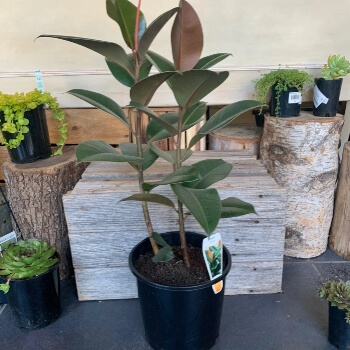 Source: flairdesign.net.au |
Ficus elastica ‘Robusta’Ficus elastica ‘Robusta’ is hardier and has bigger leaves than the Decora variety. It’s considered a more modern version of the Ficus elastica var. decora with thick stems and glossy leaves. You’ll need a pot around 14cm in diameter. ‘Robusta’ can handle low humidity and can reach a height of around 1.8 metres. | 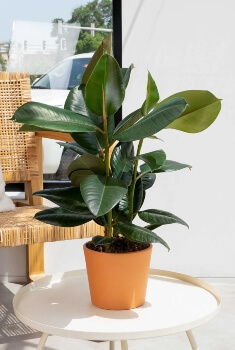 Source: flowers.ie |
Ficus elastica ‘Black Prince’ or ‘Burgundy’Ficus ‘Black Prince’ or ‘Burgundy’ is known for reddish black leaves that are very thick and variegated. It needs lots of bright light and also humidity to get and maintain its beautiful colour. They can grow up to 3 metres in height. | 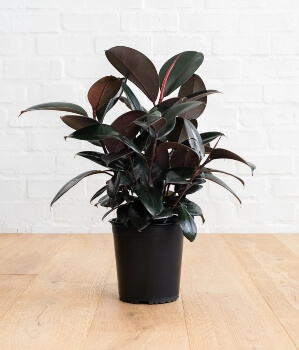 Source: peppyflora.com |
Ficus elastica ‘Ruby’Ficus ‘Ruby’ is variegated and has big dark green leaves with lots of variegation with shades of purple, red, and white. When new leaves sprout they are a lovely pink-red colour. The variety can grow up to 4 metres tall. | 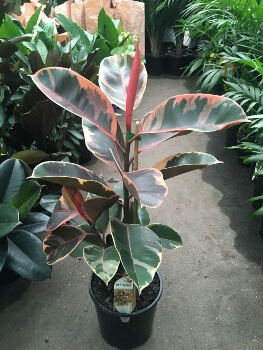 Source: westlakenursery.com.au |
Ficus elastica ‘Doescheri’Ficus ‘Doescheri’ has shades of green and yellow. The leaves look blotchy and the variety is evergreen. The edges of the leaves have a cream colour outline. This Ficus elastica can grow to 4 metres. |  Source: onlineplantguide.com |
Ficus elastica ‘Tineke’Ficus ‘Tineke’ looks a bit like an army khaki and is more compact than the Doescheri variety. This particular cultivar is variegated and has dark and light green leaves with cream colour margins and pink stems. The Ficus elastica ‘Tineke’ is great for your smaller pots. | 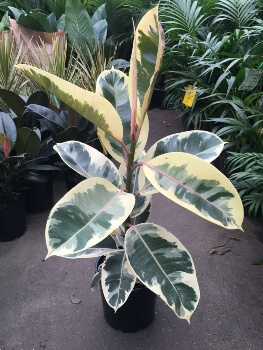 Source: westlakenursery.com.au |
Ficus elastica var. decora

Source: flairdesign.net.au
Ficus elastica var. decora is probably the most common one. The leaves are shiny, broad in size, growing up to 30 centimetres in length, and feel like leather. When the leaves are young they tend to be a bronze colour.
Ficus elastica ‘Robusta’

Source: flowers.ie


Get Your Free Guide:
Master Growing Australian Natives eBook
A Must Have Complete Guide for Every Australian Garden
Get Your Free Guide:
Master Growing Australian Natives eBook
A Must Have Complete Guide for Every Australian Garden
Ficus elastica ‘Robusta’ is hardier and has bigger leaves than the Decora variety. It’s considered a more modern version of the Ficus elastica var. decora with thick stems and glossy leaves. You’ll need a pot around 14cm in diameter. ‘Robusta’ can handle low humidity and can reach a height of around 1.8 metres.
Ficus elastica ‘Black Prince’ or ‘Burgundy’

Source: peppyflora.com
Ficus ‘Black Prince’ or ‘Burgundy’ is known for reddish black leaves that are very thick and variegated. It needs lots of bright light and also humidity to get and maintain its beautiful colour. They can grow up to 3 metres in height.
Ficus elastica ‘Ruby’

Source: westlakenursery.com.au
Ficus ‘Ruby’ is variegated and has big dark green leaves with lots of variegation with shades of purple, red, and white. When new leaves sprout they are a lovely pink-red colour. The variety can grow up to 4 metres tall.
Ficus elastica ‘Doescheri’

Source: onlineplantguide.com
Ficus ‘Doescheri’ has shades of green and yellow. The leaves look blotchy and the variety is evergreen. The edges of the leaves have a cream colour outline. This Ficus elastica can grow to 4 metres.
Ficus elastica ‘Tineke’

Source: westlakenursery.com.au
Ficus ‘Tineke’ looks a bit like an army khaki and is more compact than the Doescheri variety. This particular cultivar is variegated and has dark and light green leaves with cream colour margins and pink stems. The Ficus elastica ‘Tineke’ is great for your smaller pots.
Growing Ficus elastica in Australia
Best Conditions for Planting Rubber Trees
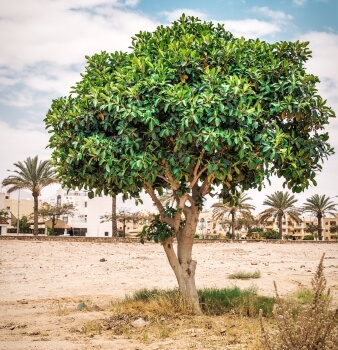
Temperature
The rubber tree likes a temperature range of between 15 and 24 degrees Celsius. Try not to expose the tree to big temperature drops or a draft.
Sunlight
Your rubber fig will need to be somewhere with bright light but shouldn’t be in direct sunlight. The different varieties also have their own light needs. The green ones can handle some shade but not for too long.
The variegated cultivars might end up losing their lovely colouring if they get too much shade.
Soil
The soil mix you choose needs to be well-draining and have good air circulation. You could use a combination of peat, coarse sand and bark.
Humidity
The rubber fig is perfectly happy with normal humidity. If you want to give it a humidity boost, you can mist its leaves in the warmer months.
Propagating Rubber Plant

If you’re ready to propagate your own rubber tree, it’s quite an easy process which we’ve included in the steps below. Summertime is probably your best bet for propagation success.
You’ll need to cut a stem between 10 and 15 cm in length. A growing tip is a good choice. You can take all the leaves off the stem, and leave just one. You might notice that the cutting is oozing sap and you can wait until it’s ready and then just wash off the leakage.
For a kick start, you can dip the cut end of the stem into a rooting hormone but this is not a must. You’re then going to plant your cutting in perlite or otherwise quite gritty compost.
Keep the mixture just moist enough and place the cutting somewhere that is warm and that has indirect light.
Caring for Rubber Plant
Fertiliser
Your Ficus elastica will need some feeding during the spring and summer months. You can feed every 2 weeks using a liquid fertiliser that’s been diluted. You shouldn’t fertilise in winter and if you have repotted your rubber tree recently, then wait between 3 and 6 months.
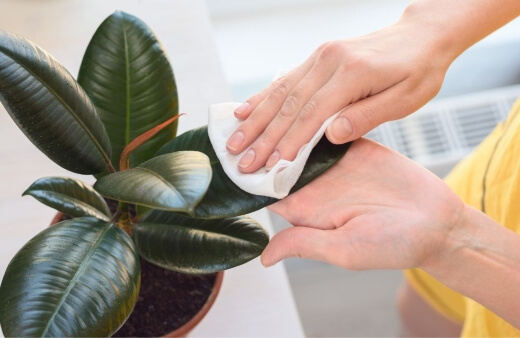
Water
The best guideline for when to water is when the soil feels slightly dry. The pot that the rubber tree is in should have good drainage. We need to caution against giving your tree too much water.
Ficus elastica likes lots of water during their growing phase but the roots should never be left wet. By letting the soil dry out between each watering session, you’re giving your rubber tree the best chance.
Pruning
We recommend pruning in the spring or summer months. Cutting off unnecessary branches means your tree will keep a good shape. You can also manage the height by cutting off the top once you feel it’s tall enough.
Repotting
You’ll need to repot your Ficus elastica once a year as a young tree, and then every 3 years when the tree is more established. It’s a good idea to provide fresh soil once a year. What’s amazing is that the rubber fig can grow big, even in a small pot.
You will eventually notice though that the growth slows or stops altogether if you don’t repot. Some gardeners prefer to do topdressing instead of repotting.
This basically means you are scraping off a top layer of old soil and adding fresh compost and nutrients back into the soil. If you’re going the repotting route, you can just transplant into a bigger pot with an everyday potting mixture.
Pests and Diseases that Affect Ficus elastica
Scale
Scale can sometimes be hard to see and often is even harder to get rid of. The brown exterior of the pest makes it hard to spot on a leaf and they tend to blend in well with their surroundings.
A good way to diagnose whether you are dealing with scale is to look for the honeydew they leave behind. The honeydew is what then causes the plant or tree to develop sooty mould. Check on the underneath side of your tree leaves and on the stems.
Getting rid of scale means getting rid of their outer shell successfully. It takes some persistence and you’ll need to do some repeat treatments on your tree before you’re rid of the pest.
For a small scale infestation, you can actually pick off the scales by hand. Another successful remedy is to dab the pest with rubbing alcohol.
Red Spider Mites
This pest can be a bit of a nightmare because they are difficult to get rid of. They spin webs on your tree and live off the plant leaf liquid. The colony of mites can grow really quickly.
If you notice some new webs on your plants or leaves that have lots of brown dots, you’re probably dealing with the red spider mite. The ideal way to get rid of the mites is using water and humidity.
You can give your plant or tree a weekly shower with gentle water and then also mist it each day to create humidity. This helps get rid of the webs and sends the mites packing.
Check out our guide for more info on spider mites and how to get rid of them organically.
Ficus elastica Frequently Asked Questions
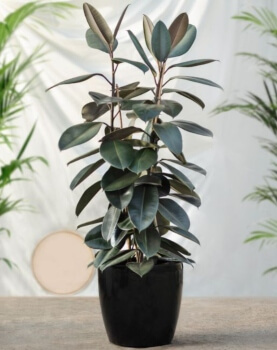
How quickly does the rubber tree grow?
Ficus elastica is a fast growing tree. Some gardeners like to move their rubber tree outside during summer which can offer a burst of new leaves. You’ll need to monitor the amount of sunlight the tree gets carefully.
What kind of height and spread does the rubber tree have?
The size of your Ficus elastica is really going to depend on the care that it gets. If the pot is big enough and you don’t prune often, the tree can grow up to 3 metres high. A smaller pot would result in a shorter tree.
When it comes to the width of the rubber tree, this can be managed through the pruning process. If you opt not to prune, you’ll end up with a narrower tree. For a bushy and more spread out look, you can prune the top growth tips.
This will create new growth on the side of the tree. The maximum indoor spread of the Ficus elastica is probably around 1 metre.
Does the rubber tree produce any flowers?
Ficus elastica is part of the fig family. That means you won’t be getting any eye-catching or sweet smelling flowers, but you don’t even need them. The rubber fig leaves are beautiful enough.
When the new leaves start growing, they actually grow from a red covering which is lovely. The tree also sometimes produces a small, fig-like fruit.
Perhaps all your garden needs is somewhere to sit and admire the beauty. Have a look through our best hanging chairs in Australia guide to find the seating that’s perfect for you.
Looking for more gardening tips and inspiration, or just wanting to brush up on your plant knowledge? Sign up for our newsletter and enjoy plant profiles, honest reviews, and helpful advice.
Wrapping Up Our Ficus elastica Growing and Care Guide
Living décor that cleans the air? Yes please. The rubber tree is bound to be a talking point in any home, and I believe there is no such thing as a home with too many plants.
You can choose a green or variegated cultivar (perhaps to match colour in some of your other décor), and maintain a size that works for your home through pruning. I’m definitely giving the Ficus elastica my green thumbs up.
Published on October 21, 2022 by Maisie Blevins
Last Updated on February 22, 2025




